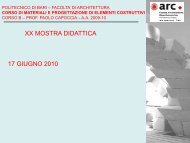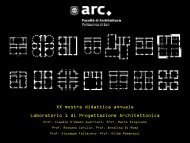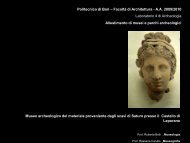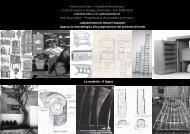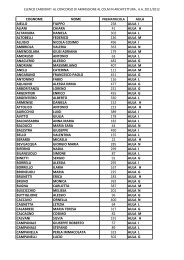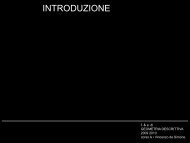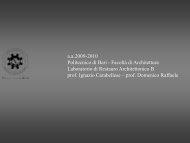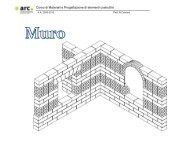44. I regolamenti <strong>di</strong>dattici112dell’architettura), sia all’attivitàprogettuale, <strong>di</strong>rettamente <strong>di</strong>scendentedalla definizione del modello formale,costruttivo e strutturale della stessaarchitetturaTeorie e tecniche costruttive nel lorosv<strong>il</strong>uppo storicoQuesto insegnamento ha l’obiettivo <strong>di</strong>fornire agli allievi gli strumenti specialisticiper la progettazione degli interventi <strong>di</strong>restauro strutturale dell’architettura, inmodo da garantire <strong>il</strong> grado <strong>di</strong> sicurezzarichiesto nel rispetto della identità storica ecostruttiva dell’e<strong>di</strong>ficio.Il percorso <strong>di</strong> appren<strong>di</strong>mento,coerentemente con quella che è lacaratterizzazione del secondo ciclo, sisvolge attraverso <strong>il</strong> contatto <strong>di</strong>retto con <strong>il</strong>monumento e l’esercizio del progetto <strong>di</strong>Restauro.Articulation of educational activitiesThe Restoration Stu<strong>di</strong>o is composed of twoteachings: Architectural Restoration,Theory and Techniques of Construction intheir historical development, whosetheoretical lessons and applied activitiesare developed in a strict coor<strong>di</strong>nation.Architectural restorationTheoretical learning is aimed at theknowledge of the construction and of its<strong>di</strong>fferent connotations, and at the definitionof a methodology for the interventionwhich is coherent with the theoreticalprinciples of conservation of the historicalimage of the monument. Applied activitiesare related both to the documentation ofthe monument in the actual con<strong>di</strong>tions(architectural survey) and to thedevelopment of the restoration project,which <strong>di</strong>rectly derives from the formal,constructive and structural model.Theory and techniques of construction andtheir historical developmentThe course is aimed at provi<strong>di</strong>ng to thestudents specialist tools for designingarchitectural rehab<strong>il</strong>itation interventions, inorder to guarantee the required safety levelwh<strong>il</strong>e respecting, at the same time, thearchitectural and constructive identity ofthe monument.The learning method is based on the <strong>di</strong>rectcontact with the monument and thepractical application of the RestorationDesign.Corso A/ Rossella de Cad<strong>il</strong>hac, Giosi UvaTema d’annoArchitetture men<strong>di</strong>canti <strong>di</strong> PugliaDesign ProblemMen<strong>di</strong>cant cloister of ApuliaLezioni <strong>di</strong> Restauro architettonico AIl tema d’anno sono le architetturemen<strong>di</strong>canti, che, particolarmente <strong>di</strong>ffuse inPuglia, confermano una continuitàcostruttiva sul territorio che si è avvalsadell’uso della pietra come segno <strong>di</strong>stintivoed inequivocab<strong>il</strong>e. Conoscere <strong>il</strong> precisolinguaggio architettonico che le connota èla ineliminab<strong>il</strong>e premessa per intervenirecon consapevolezza critica e cognizionetecnica su quelle testimonianze chereclamano un intervento <strong>di</strong> restauro.I contenuti delle lezioni sono <strong>il</strong>lustrati insuccessione logica dalla fase dellaconoscenza alle problematiche progettuali:- La storia come fondamento del restauro- I materiali dell’ed<strong>il</strong>izia storica e le tecnichecostruttive tra<strong>di</strong>zionali- I fenomeni <strong>di</strong> deterioramento- La <strong>di</strong>agnostica- Il restauro dei materiali e delle superfici- Le carte del restauro e <strong>il</strong> quadrolegislativo attuale- I no<strong>di</strong> problematici del restauro- Un caso <strong>di</strong> restauro esemplareTopics of architectural restoration AThe design study cases are men<strong>di</strong>cantcloisters. They confirm a particulararchitectural tra<strong>di</strong>tion that underwent acharacteristic development in Apulia. Theybear witness to a form of bu<strong>il</strong><strong>di</strong>ngcontinuity over the territory that bears theuse of stone, as its <strong>di</strong>stinctive, unequivocalmark. A knowledge of the specificarchitectural expression that characterizesaxial domed churches is an essentialpremise in order to be able to operate witha full historical-critical awareness and duetechnical sk<strong>il</strong>ls on those identifie<strong>di</strong>nstances requiring restoration work.The contents of the lessons are <strong>il</strong>lustrate<strong>di</strong>n sequence from knowledge to project:- History as foundation of restoration- Materials of historical architecture andtra<strong>di</strong>tional bu<strong>il</strong><strong>di</strong>ng techniques- Decay phenomena- Diagnosis- Restoration of materials and surfaces- Restoration chartas and current laws- Restoration problem nodes- An exemplary case of restorationLezioni <strong>di</strong> ‘Teorie e tecniche costruttive nelloro sv<strong>il</strong>uppo storico’ AA supporto dello sv<strong>il</strong>uppo del temaprogettuale, durante le lezioni ex-cathedrasaranno fornite le basi teoriche e tecnicheper la comprensione del funzionamentostrutturale degli e<strong>di</strong>fici monumentali,affinché l’allievo acquisisca la capacità <strong>di</strong>definire <strong>il</strong> modello strutturale e costruttivoe che sarà poi al centro delle attività dellaboratorio.Particolare attenzione sarà de<strong>di</strong>cataall’in<strong>di</strong>viduazione della “regola dell’arte”,sulla base della trattatistica storica edell’esame <strong>di</strong> alcuni e<strong>di</strong>fici esemplari, e alladefinizione <strong>di</strong> un modello <strong>di</strong> e<strong>di</strong>ficio adossatura muraria ‘ideale’ in termini <strong>di</strong>organizzazione strutturale, apparecchiaturae tessitura dei vari elementi portanti e curadegli elementi <strong>di</strong> connessione tra le parti edei dettagli costruttivi. Su questa base sipotranno riconoscere tutte le carenze <strong>di</strong>impianto strutturale, congenite o acquisitedurante l’evoluzione storica dell’organismoed<strong>il</strong>izio. Saranno poi <strong>il</strong>lustrate le attual<strong>il</strong>inee guida per la sicurezza strutturale, conriferimento ad un sistematico esame dellemodalità <strong>di</strong> collasso più frequenti per latipologia ed<strong>il</strong>izia muraria e alle normativetecniche adottate a livello nazionale e<strong>di</strong>nternazionale.A supporto della modellazione strutturale edei calcoli e delle verifiche statiche su cui <strong>il</strong>progetto <strong>di</strong> restauro deve basarsi si faràriferimento, oltre agli strumenti classicidella statica grafica e della meccanica deimateriali, a strumenti innovativi <strong>di</strong>modellazione, anche tri<strong>di</strong>mensionale.Topics of ‘Theory and Techniques ofConstruction in their historicaldevelopment’ A
During the lessons, theoretical andtechnical bases w<strong>il</strong>l be provided, in order tosupport the practical development of thein<strong>di</strong>vidual design theme, allow thecomprehension of the structural behaviourof monumental bu<strong>il</strong><strong>di</strong>ngs and the definitionof the constructive and structural model.A specific attention w<strong>il</strong>l be devoted to thestudy of the “rule of the art” (on the baseof historical treatises and the analysis ofpara<strong>di</strong>gmatic case stu<strong>di</strong>es) and to thedefinition of the ideal model (with regard tothe structural arrangement, masonrytexture, constructive elements,connections, structural deta<strong>il</strong>s). It w<strong>il</strong>l thenbe possible to identify the defects in thestructural organization (either intrinsic orinduced by external events).During the course the modern guidelinesfor the structural safety of historicalconstructions w<strong>il</strong>l be <strong>il</strong>lustrated, by asystematic analysis of recurrent collapsemodes and of the technical codes actuallyadopted at international and national level.The phase of the structural modelling andverification w<strong>il</strong>l be supported by thetra<strong>di</strong>tional tools of graphical statics and byadvanced 3D modelling methods.EsercitazioniLe esercitazioni in aula si conducono ingruppi <strong>di</strong> non più <strong>di</strong> tre allievi sumonumenti concordati con la docenza, iquali siano esemplificativi <strong>di</strong> alcune delleproblematiche <strong>di</strong>sciplinari.Il tema d’anno verrà stu<strong>di</strong>ato per fasisuccessive:1. La conoscenza (stu<strong>di</strong>o <strong>di</strong>retto delmonumento e analisi storica)2. L’analisi (articolazione spaziale,consistenza materiale, specificitàcostruttive e figurative, fenomeni <strong>di</strong>degrado e meccanismi <strong>di</strong> danno)3. Il progetto (problemi <strong>di</strong> smontaggio erimontaggio, integrazione delle lacune,rimozione <strong>di</strong> aggiunte, completamento,consolidamento, riconversione d’uso).ExercisesExercises are drawn up by groups of threestudents. The churches analysed by eachgroup are representative of some typicalrestoration knots. The study case isanalysed along successive phases:1. Knowledge (architectural survey andhistorical study);2. Analysis (spatial articulations, physicalconsistency, formal aspects, decayphenomena, structural damage);3. Design problems concerning<strong>di</strong>sassembling and reassembling of theworks, f<strong>il</strong>ling in the gaps in walls, removingad<strong>di</strong>tions, completing structures, lookingfor consolidation solutions, changing thefunction of bu<strong>il</strong><strong>di</strong>ngs.Corso B/ Ignazio Carabellese, DomenicoRaffaeleTema d’annoCampan<strong>il</strong>i d’età barocca in Terra <strong>di</strong> <strong>Bari</strong>Design ProblemBaroque bell towers in Terra <strong>di</strong> <strong>Bari</strong>Lezioni <strong>di</strong> Restauro architettonico B- Motivi del restauro – oggetto del restauro– approccio metodologico – spiegazionedei termini caratterizzanti la <strong>di</strong>sciplina(glossario del restauro)- Inquadramento storico delle strutturemurarie: Degrado e <strong>di</strong>ssesto: <strong>il</strong> <strong>di</strong>ssesto e iquadri fessurativi; - Diagnostica generale;Cause e rime<strong>di</strong>; Rapporto tra forma eresistenza delle strutture agli eventi dellastoria- Il r<strong>il</strong>ievo per <strong>il</strong> restauro: <strong>di</strong>mensioni,qualità, struttura- Storia e restauro – meto<strong>di</strong> <strong>di</strong> indagine : lefonti e i luoghi della ricerca, rapporto fraconoscenza storica e progetto- Anatomia e fisiologia delle fabbrichetra<strong>di</strong>zionali: materiali – fondazioni –murature in elevazione- Anatomia e fisiologia delle fabbrichetra<strong>di</strong>zionali: orizzontamenti – coperture –impianti- Cause e meccanismi del degrado –Patologie dei materiali lapidei- L’umi<strong>di</strong>tà ed <strong>il</strong> risanamento igienico dellecostruzioni- Il concetto <strong>di</strong> identità nelle sue possib<strong>il</strong>iimplicazioni – con<strong>di</strong>zioni ambientali e suoiriflessi sul progetto <strong>di</strong> restauro- I no<strong>di</strong> critici del Restauro architettonico:integrazione delle lacune; rimozione delleaggiunte; sostituzione; restauro della materia;completamento;ripristino; anast<strong>il</strong>osi;smontaggio e rimontaggio- I documenti della cultura del restauro;- Il progetto <strong>di</strong> Restauro: impostazione delprogetto; pre<strong>di</strong>sposizione degli elaborati,ecc- La tutela e la norma: evoluzione econtenuti della normativa <strong>di</strong> tutela- Tecniche <strong>di</strong> intervento: opereprovvisionali; risanamento econsolidamento <strong>di</strong> strutture murarie:fondazioni e murature in elevato- Tecniche <strong>di</strong> intervento: strutture <strong>di</strong>orizzontamento: solai, volte, cupole,coperture- Temi e argomenti <strong>di</strong> restauro: descrizionee <strong>di</strong>scussione <strong>di</strong> alcuni interventi esemplari<strong>di</strong> restauro architettonico in Italia e inEuropaTopics of architectural restoration B- Reasons for the restoration - object of therestoration - methodological approach -explanation of the specific terms of the<strong>di</strong>scipline (glossary of the restoration)- Historical organization of the bu<strong>il</strong><strong>di</strong>ngstructures: degrade and <strong>di</strong>sarrangement:the <strong>di</strong>sarrangement and the ruptureframes; - general <strong>di</strong>agnostics; Causes andreme<strong>di</strong>es; Relationship between form andresistance of the structures to the events ofthe history- Detection for the restoration: <strong>di</strong>mensions,quality, structure- History and restoration - methods ofinvestigation: the sources and the places ofthe research, relationship betweenhistorical knowledge and project.- Anatomy and physiology of the tra<strong>di</strong>tionalbu<strong>il</strong><strong>di</strong>ngs: material - foundations -masonries- Anatomy and physiology of the tra<strong>di</strong>tionalfactories: floorings and ce<strong>il</strong>ings - coverages- fittings- Causes and mechanisms of the degrade -Pathologies of stones- The damp and the hygienic improvementof bu<strong>il</strong><strong>di</strong>ngs- The concept of identity in its implications -environmental con<strong>di</strong>tions and theirinfluences on the restoration choices- The critical nodes of architectural44.2.10 Progetti <strong>di</strong>dattici del II ciclo del CdLm in Architettura113
- Page 1:
0607Politecnico di BariFacoltà di
- Page 4 and 5:
Politecnico di Bari, Facoltà di Ar
- Page 6 and 7:
4. Regolamenti didattici4.1. Il Reg
- Page 8 and 9:
PresentazionePresentazioneLa Facolt
- Page 11 and 12:
Le strutture didattiche e di suppor
- Page 13 and 14:
giorno e dando, quindi, esecutivit
- Page 15 and 16:
• esprimere pareri sui compiti di
- Page 17 and 18:
1.3. La Biblioteca di FacoltàIl pa
- Page 19 and 20:
2. Strutture di ricerca e di suppor
- Page 21 and 22:
BIO 07, Ecologia43 Mariavaleria Min
- Page 23 and 24:
le richieste e le iniziative ad ess
- Page 25:
2.3 Le biblioteche d’area2.3.1 Le
- Page 28 and 29:
33. La didattica e gli studenti263.
- Page 31 and 32:
4. I Regolamenti didattici4.1. Rego
- Page 33 and 34:
presente regolamento;• le propede
- Page 35 and 36:
discussi ed i voti finali.Per ciasc
- Page 37 and 38:
4.2.4 Definizione delle aree discip
- Page 39 and 40:
laurea da attivare in base al numer
- Page 41 and 42:
non venga superato l’iscrizione a
- Page 43 and 44:
Manifesto del CdLs in Architettura
- Page 45 and 46:
Manifesto del CdLm in Architettura
- Page 47 and 48:
ciclo provenendo da altri Atenei.È
- Page 49 and 50:
Manifesto del CdLs in Architettura
- Page 51 and 52:
Manifesto del CdLm in Architettura
- Page 53 and 54:
Insegnamenti ssd Crediti Laboratori
- Page 55 and 56:
Insegnamenti ssd Crediti Laboratori
- Page 57 and 58:
Insegnamenti attivati e docenti per
- Page 59 and 60:
Insegnamenti attivati e docenti per
- Page 61 and 62:
Finalità e contenuti disciplinariN
- Page 63 and 64: Lezioni- L’architettura etrusca e
- Page 65 and 66: ibliografiche, volte ad acquisire g
- Page 67 and 68: Discipline tecnologiche per l’Arc
- Page 69 and 70: Istituzioni di geometria I + Istitu
- Page 71 and 72: architettonicoTopicsLife drawing, u
- Page 73 and 74: • Representation of the shadows
- Page 75 and 76: frequenza del corso che consentel
- Page 77 and 78: capacità di valutazione storico-cr
- Page 79 and 80: scale edilizie e tra diversi tipi;
- Page 81 and 82: planning of Roman suburban andcount
- Page 83 and 84: mutation through the works of the p
- Page 85 and 86: -Equazioni indefinite di equilibrio
- Page 87 and 88: coerenza tra qualità funzionale, c
- Page 89 and 90: transformations (psychrometry).In t
- Page 91 and 92: madrepatria.4. La colonizzazione e
- Page 93 and 94: EtruscologiaEtruscologyL-ANT/07 - 4
- Page 95 and 96: Archeologia e Storia dell’Arte Ro
- Page 97 and 98: The student will develope the archi
- Page 99 and 100: tanto il rapporto tra elementi, str
- Page 101 and 102: sociale dell’abitare (Loos, Tesse
- Page 103 and 104: experimental research into the beha
- Page 105 and 106: Articolazione dell’attività dida
- Page 107 and 108: Aims and contentsThe Urban Sociolog
- Page 109 and 110: nell’ambito dell’annuale “mos
- Page 111 and 112: di laurea. Sarà quindi necessario
- Page 113: - Ancient modern Rome: the continui
- Page 117 and 118: Le esercitazioni costituiscono lo s
- Page 119 and 120: typological and technical innovatio
- Page 121 and 122: • la fenomeni di propagazione del
- Page 123 and 124: Aims and contentsThe urban economy,
- Page 125 and 126: value of a civil apartment with the
- Page 127 and 128: l’elaborazione della tesi di rice
- Page 129 and 130: 4.3.8 Esame di laureaPer essere amm
- Page 131 and 132: semestrale• Laboratori di sintesi
- Page 133 and 134: 4.3.14 Manifesto del CdL in Disegno
- Page 135 and 136: 4.3.16 Organizzazione delle attivit
- Page 137 and 138: 4.3.17 Insegnamenti e docenti per a
- Page 139 and 140: Laboratorio di Disegno industriale
- Page 141 and 142: • metodo dell’assonometria;•
- Page 143 and 144: fine dell’Ottocento; le avanguard
- Page 145 and 146: Iscrizione al corsoLe iscrizioni av
- Page 147 and 148: Laboratorio di Arredamento 2/IInter
- Page 149 and 150: Disegno 2/IIDrawing 2/IIIcar 17-5 c
- Page 151 and 152: communication, as follows:• typog
- Page 153 and 154: 4.3.22 Progetti didattici3° anno
- Page 155 and 156: sintetiche, segnaletica interna ed
- Page 157: esercitazioni pratiche, attività d
- Page 160 and 161: 55. Relazioni internazionali1585.1
- Page 163 and 164: 6. Post Lauream6.1. Dottorato di Ri
- Page 165 and 166:
Attività di ricercaLo svolgimento
- Page 167 and 168:
particolari e specifiche competenze
- Page 169 and 170:
iscrizione all’esame di ammission
- Page 171 and 172:
scientifico-disciplinare in cui è
- Page 173:
• alla sicurezza statica (corrett
- Page 176 and 177:
a.1 Planimetria del campus epiante
- Page 178 and 179:
Status accademico dei docentiDocent
- Page 180 and 181:
aAppendici178A.3 Indice dei nomiAAc
- Page 182 and 183:
aAppendicia.5 Calendario annuale de




